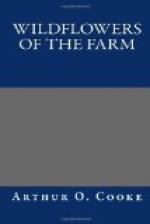Those of the Red Clover grow on stems branching from the flower stem, and sometimes on the flower stem itself. Both leaves and stems are hairy, and on the leaves there is generally a white mark, something the shape of a horseshoe.
The leaves of the White Clover grow, like the flower, at the top of the stem—a single leaf on each stem. The under sides of the leaves are smooth and glossy. The leaves of the Crimson Clover grow on the flower stems like those of the Red Clover; but the leaflets are broader and rounder than the Red Clover leaflets. The Crimson Clover is an annual, while the others are perennials.
All these clovers are good food for the farmer’s animals or stock. The Red Clover is, perhaps, the most useful. Bees, however, prefer the White Clover, for they can more easily get at its nectar.
Sheep are exceedingly fond of Clover, but Mr. Hammond is always careful not to turn them into a field of Clover when they are very hungry, or to let them stray in by accident. If they got in they would eat it ravenously, and many would very likely die. Too hearty a meal of Clover has the same effect on them as a great quantity of new bread would have on you or me.
We have spent so much time this morning looking at the clovers that we have only a minute or two to stand at the gate of a field of beans. The blossoms are pretty—white with dark spots—and they are very fragrant. A field of beans in flower gives us one of the most delightful of all country scents.
CHAPTER VI
In “Ashmead”
There are many other flowers besides the Clover in Ashmead to-day, and this afternoon we will look at some that grow among the grass. One of these you may perhaps call a weed, yet it is one of the most beautiful wild flowers in England. I mean the golden Dandelion.
On a lawn or in a garden bed it would certainly be a weed, and a very troublesome one. Here among the grass we need only think of it as a very lovely flower. See what a rich golden yellow the little florets of the blossom are. Plants like the Dandelion, in which the blossom is composed of a number of florets, are called “composite” plants.
If we examine the plant closely we shall find that each stalk which bears a blossom, and each long deeply indented leaf, grows, like the flower-stem and leaf of the Primrose, from a very short underground stem. It is from the indented leaves that the Dandelion gets its name. The leaves have something the appearance of the teeth of a lion. Now the French name for lion’s tooth is dent de lion, and we English have corrupted this into dandelion.
Each flower-stem is round and, when we pull one, we see that it is a hollow tube. We bite a piece of the stalk as we did with the Clover blossom. What a difference! The Clover was quite sweet, but the Dandelion is very bitter. You may not like the taste perhaps, but the white milky-looking juice is quite wholesome. Dandelion tea and Dandelion beer are often made by country people, and the leaves give a pleasant flavour to a salad.




